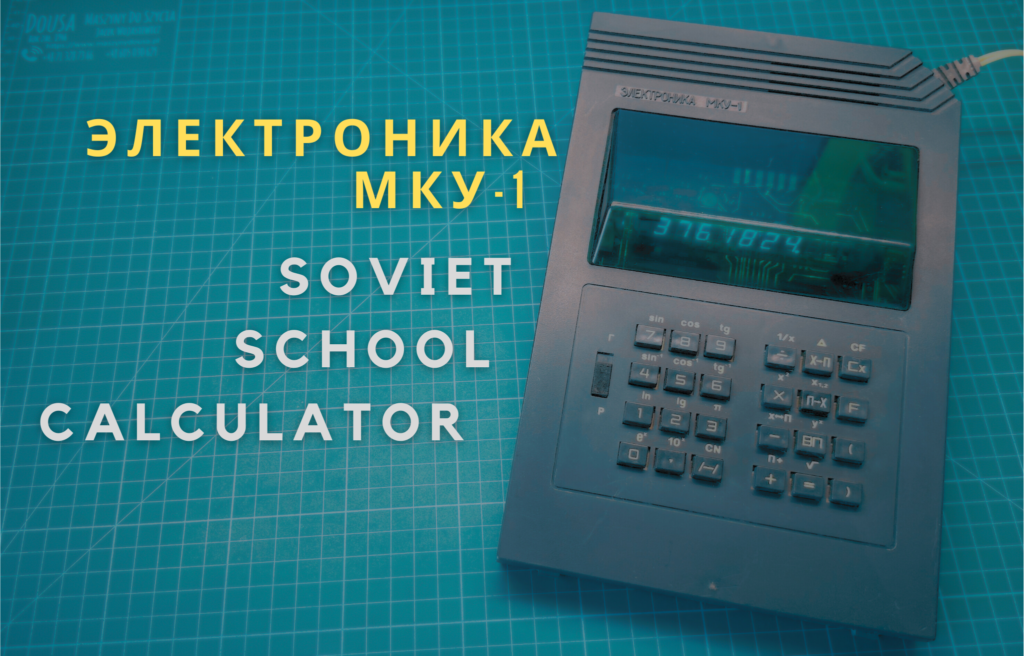In this material I would like to show you another device from across our eastern border. This time it will be a counting device called a calculator, which was commonly used by students and high school students of the Soviet Union.

The story of our today’s hero begins in 1987. It is then that the electronic equipment factory in Svetlovodsk (today’s Ukraine) leaves the first calculator Электроника МКУ-1 (Elektronika MKU-1). The device was the result of an idea by officials of the Central Planning Bureau and was designed with a specific purpose in mind – the equipment was to serve high school and college students of the Soviet Union. It would enable them to solve even complex mathematical equations much more quickly and simply.
The use of the calculator as school equipment forced the designers to design two versions, differing in power supply voltage. In those days, but also today, classrooms in Russian schools are equipped with sockets where the voltage is 42V. Such a solution is used primarily for safety reasons, however, to hurt yourself with 42V is a bit more difficult than with standard 230V. In addition to the typical school calculator, there was also a home version powered by the slightly more widely known 230V, it is such a device that is part of my collection and I will present it to you a little closer today.

The device is enclosed in a rather interesting casing, and this is not typical of designs derived from centrally planned economies. At first glance, we see an ordinary cuboid, but looking more closely, we can see details that give it a certain fancy. First of all, one of the corners has been beveled, and on the resulting surface there is an opening from which the power cable is routed. At the top of the chassis was placed a ribbing, running through most of the device parallel to the top edge. Only at the end was it placed at a certain angle, so as to fit into the truncated corner. In addition to its aesthetic function, the embossing also has some practical use. It places holes to dissipate heat from inside the calculator. The display cover is also an interesting element of the case. It is quite large in size and could definitely be smaller, after all, the VFD lamp that is the display is located in the front part. The rest of the semi-transparent plastic protects the components on the motherboard. I have to admit that this is an interesting solution, perhaps the view of electronic components was somehow meant to fascinate students, so that they would become interested in electronics.
Below the display is the keyboard. It consists of 24 buttons, symmetrically placed in two equal groups. Due to the multitude of supported functions, markings are placed both on the buttons and above them. As for the user experience of the keyboard, there is nothing to complain about, despite the passage of years it works very well. On the left side of the keyboard there is a two-position switch for selecting degrees or radians as the unit for describing angles.

On the bottom of the calculator you will find nothing but a nameplate. It bears the model designation, serial number and production date of 02 (month or week) 1989.
What do we find inside?

After unscrewing two screws at the top and bottom edge, we can split the case in two and look inside the device. In the foreground we have the main PCB, which houses the buttons, the VFD lamp that serves as the display, and all the controls. Slightly higher up was the second PCB that serves as the power module. Besides, the switch that turns the calculator on is also visible.

The module supplying power to the rest of the components is a rather simple linear power supply design, consisting of a transformer, rectifier bridge and RC filters. The rectifier diodes look quite interesting here, as if they were made of plasticine, although in reality it is obviously some kind of plastic.

We can’t say much about К145ИК1301, which is the main processor, unfortunately that’s the way it is with chips from the former USSR. This chip is a classic representative of the claculator-on-chip design, it supports a multiplexed display, and a keyboard, using the same data bus. К145ИК1301 also boasts a multitude of supported functions, as I mentioned earlier. The case itself is also interesting – it does not have a uniform texture, in the central part it is rough, and this is also where the markings are placed. Also noteworthy are the leads, there are 48 of them and they are arranged in two rows on both sides. As a curiosity, I can mention that according to the “Information book on the content of precious metals in products and components of general industrial use. Approved by the First Secretary of the CPSU in 1985 and the Ministry of Defense of the USSR in 1986.” The К145ИК1301 chip has exactly 0.0029452 grams of gold inside it.

At the left edge of the motherboard were three chips – К176ЛЕ5, К176ИЕ8, К176КТ1. These are, in turn, four, two-input OR gates (equivalent to CD4001), a decimal counter with encoder (equivalent to CD4017) and a four-channel signal switch (equivalent to CD4016).

Closer to the right edge of the PCB you will find another two chips К161КН1А, К161КН1Б both are seven-channel switchers, but what is the difference between the A and Б versions, unfortunately, I have not been able to determine.

Under the VFD lamp you will find another chip К161КН1А. Besides, from this side you can also see quite a nice rectifying diode, which does not look like it was made of plasticine.

Right next to it, we can find another interesting component the К165ГФ3 circuit, housed in a rather fancy round case with twelve leads. It is a 4-phase clock generator powered from -15V to 24V. In the photo below you can see the inside of the circuit and the silicon core under magnification.


Let’s stop for a moment at the display itself. It is formed by nothing more than a fairly common VFD tube, marked IV-18 (IW-18), found in socialist equipment; you may also associate it with Elwro calculators produced in Poland. The bubble can display eight, seven-segment characters, with the individual segments interconnected. As a result, the display has to be multiplexed, but this way we gain a smaller number of leads.

Let’s take another look at the underside of the motherboard. It is very neat, the tracks have been routed quite professionally and everything has its place here.

Finally, one more photo, where we managed to capture the glow of two parallel wires – the cathodes of the lamp.


